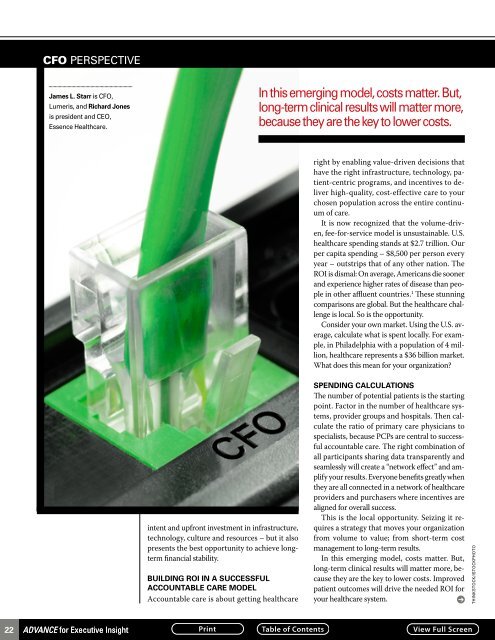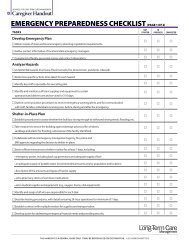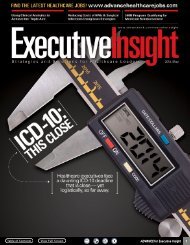ADVANCE for Executive Insight 1 ADVANCE for Executive Insight
ADVANCE for Executive Insight 1 ADVANCE for Executive Insight
ADVANCE for Executive Insight 1 ADVANCE for Executive Insight
- No tags were found...
You also want an ePaper? Increase the reach of your titles
YUMPU automatically turns print PDFs into web optimized ePapers that Google loves.
CFO perspective<br />
James L. Starr is CFO,<br />
Lumeris, and Richard Jones<br />
is president and CEO,<br />
Essence Healthcare.<br />
In this emerging model, costs matter. But,<br />
long-term clinical results will matter more,<br />
because they are the key to lower costs.<br />
right by enabling value-driven decisions that<br />
have the right infrastructure, technology, patient-centric<br />
programs, and incentives to deliver<br />
high-quality, cost-effective care to your<br />
chosen population across the entire continuum<br />
of care.<br />
It is now recognized that the volume-driven,<br />
fee-<strong>for</strong>-service model is unsustainable. U.S.<br />
healthcare spending stands at $2.7 trillion. Our<br />
per capita spending – $8,500 per person every<br />
year – outstrips that of any other nation. The<br />
ROI is dismal: On average, Americans die sooner<br />
and experience higher rates of disease than people<br />
in other affluent countries. 1 These stunning<br />
comparisons are global. But the healthcare challenge<br />
is local. So is the opportunity.<br />
Consider your own market. Using the U.S. average,<br />
calculate what is spent locally. For example,<br />
in Philadelphia with a population of 4 million,<br />
healthcare represents a $36 billion market.<br />
What does this mean <strong>for</strong> your organization?<br />
intent and upfront investment in infrastructure,<br />
technology, culture and resources – but it also<br />
presents the best opportunity to achieve longterm<br />
financial stability.<br />
Building ROI in a Successful<br />
Accountable Care Model<br />
Accountable care is about getting healthcare<br />
Spending Calculations<br />
The number of potential patients is the starting<br />
point. Factor in the number of healthcare systems,<br />
provider groups and hospitals. Then calculate<br />
the ratio of primary care physicians to<br />
specialists, because PCPs are central to successful<br />
accountable care. The right combination of<br />
all participants sharing data transparently and<br />
seamlessly will create a “network effect” and amplify<br />
your results. Everyone benefits greatly when<br />
they are all connected in a network of healthcare<br />
providers and purchasers where incentives are<br />
aligned <strong>for</strong> overall success.<br />
This is the local opportunity. Seizing it requires<br />
a strategy that moves your organization<br />
from volume to value; from short-term cost<br />
management to long-term results.<br />
In this emerging model, costs matter. But,<br />
long-term clinical results will matter more, because<br />
they are the key to lower costs. Improved<br />
patient outcomes will drive the needed ROI <strong>for</strong><br />
your healthcare system.<br />
thinkstock/istockphoto<br />
22 <strong>ADVANCE</strong> <strong>for</strong> <strong>Executive</strong> <strong>Insight</strong>









